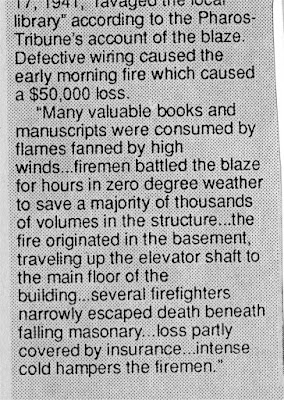In 2015, that would be in the general area where China Lane now stands.
Below is a picture of the building that, in 1894, would become the first Logansport public library, as we tend to think of it, and it stood on the same piece of real estate as it does today, 616 E. Broadway:

Opened in 1894 - Originally A Home Until 1893
The above was the home of Judge William Z. Stuart, 616 E. Broadway. After the Judge passed away, the home was rented out. On November 1, 1894, the library was opened. Miss Elizabeth McCullough was librarian and Mrs. Mary Stevens was assistant. The collection numbered 1450 volumes.
Andrew Carnegie was establishing libraries all over the nation in his name and the school trustees started a project that resulted in a $35,000 gift from Mr. Carnegie for a building. The board at that time consisted of James McNitt, J. T. Elliott and Quincy Myers.
The John E. Barnes company of Logansport was awarded the contract to construct the stone building and the formal opening of the new Logansport Carnegie library was held September 24, 1904.

Floor Plans




Rural and City
By 1918 the
local library had become a county library serving the city of Logansport plus twelve of the fourteen
townships of the county. Boone and Tipton townships each had their own Carnegie
libraries.
There
were two divisions of the library, rural and city. The entrance to the city was
on the main floor and the entrance for the rural library was on the basement
floor. Library trucks made regular runs and substations were used to aid in
extending service to rural readers.
Above: Logansport High School in the Roosevelt building stood at the corner of 7th and E. Broadway, next door to the Library. Circa 1904.
Remodeled At Various Times
The Library was remodeled at various times over the years before a fire broke out in the early morning hours of March 17, 1941.
Before the 1941 fire. (above)
After the fire 1941 (above)
Estimated loss was as high as $50,000, but exact loss couldn't be determined because a number of the books lost were priceless! Most of the books in the basement were not damaged and it appeared that more than two thirds of the 81,000 books could be salvaged.
The first steps were taken to establish a new public library on April 1, 1941 by a group of 130 city and county residents.
An organization "Friends and Patrons of the Library" was formed and Robert J. Arthur was named chairman.
On May 9, 1941, Ferd Burgman, treasurer, reported that the building, as proposed, would cost $82,000 with $29,000 from insurance and the balance from a bond issue.
A. J. Wolf Construction made the low offer of 3 bidders at $45,713.
Increase Bond Issue
On February 3, 1942, the city school board approved an additional $20,000 bond issue.
Eight hundred people attended the dedication program for the new $105,000 structure.
New Library Interior
Book Mobile
Addition 1963
Framed images in the Museum include photos and library cards.
Before adding on to the front of the building and completely remodeling
the interior in the 2000s.
Today the Logansport Cass County Public Library, 616 E. Broadway, offers all of the modern technology, conveniences and amenities, including Wi-Fi, computers and a first-rate community meeting room.














































